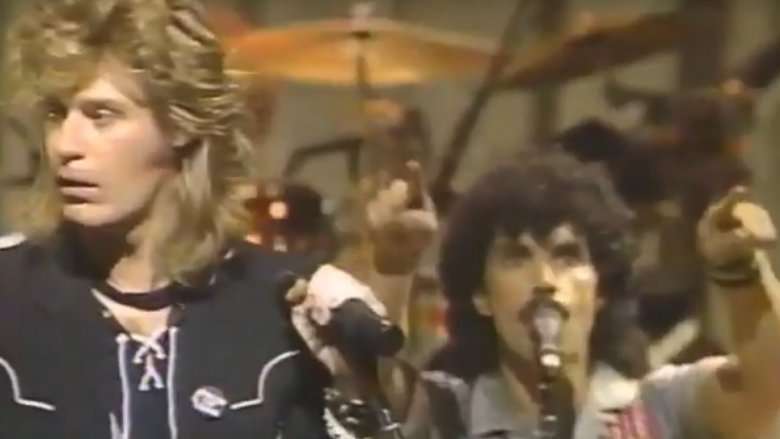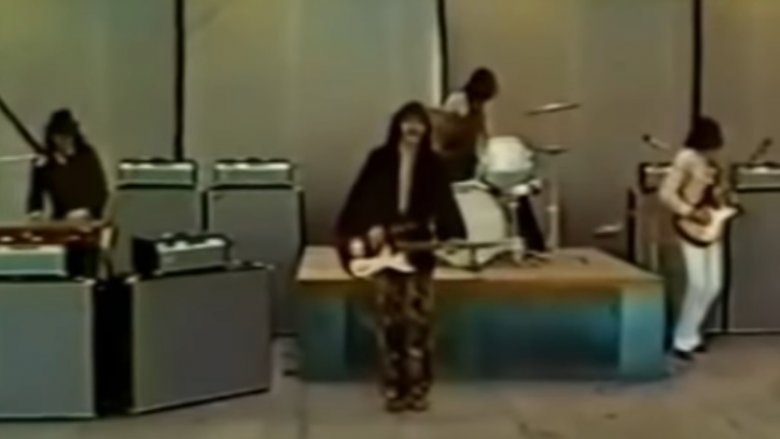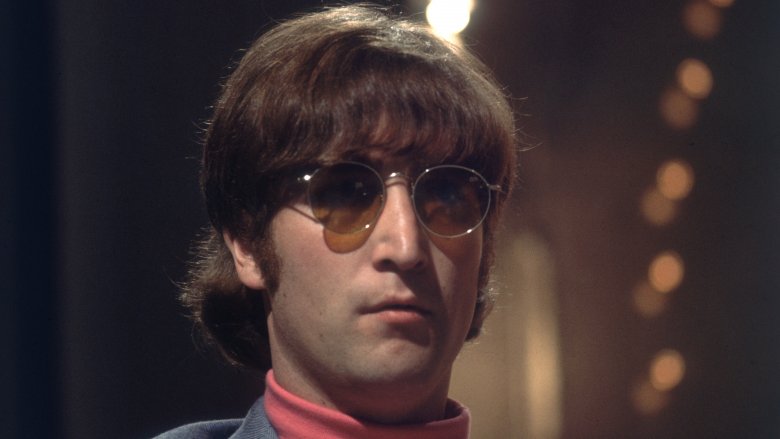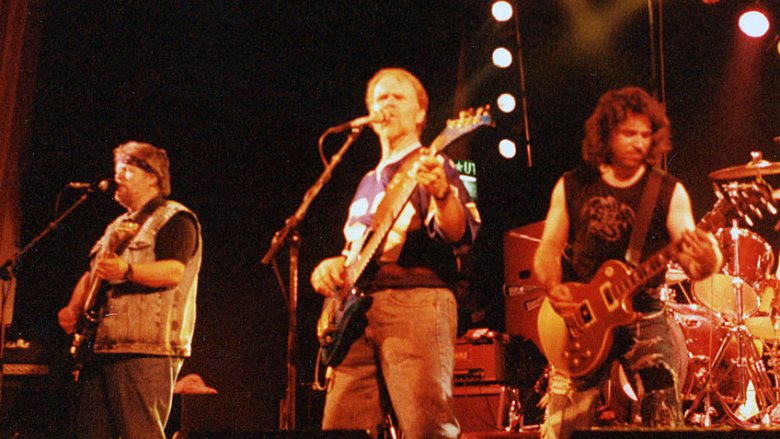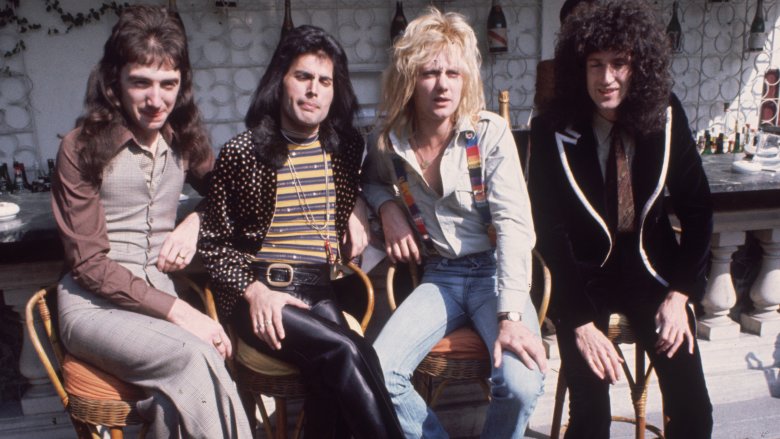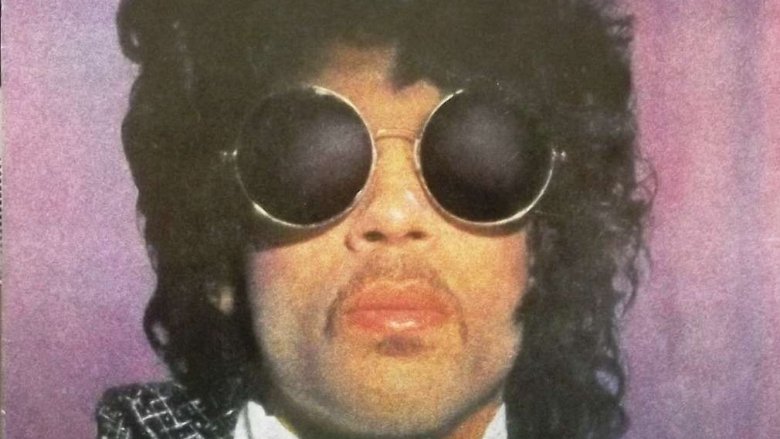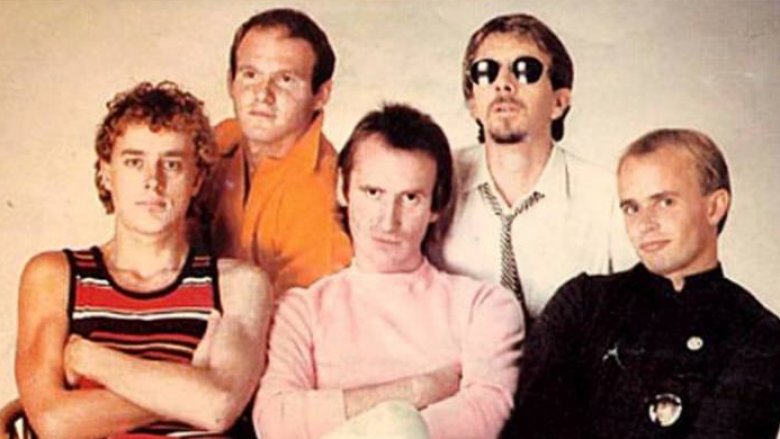Crazy True Stories Behind Popular Rock Songs
We like to think that our favorite hit songs came to the artists who created them in a burst of divine inspiration; or, failing that, a burst of potent drugs. It doesn't seem plausible that anyone could just sit down and pull a smash hit song right out of their keisters, or create an iconic tune by way of making fun of their brother in much the same fashion a twelve-year-old would, or write lyrics that fans would puzzle over for decades by simply slapping a bunch of random words and phrases together. It can't work like that... can it?
As it turns out, it absolutely can. Sometimes, inspiration bears no resemblance to an army of angels on pure white steeds, triumphantly raising their flaming swords as they crash through the gates of the artist's imagination. No, sometimes it's more like the artist's unkempt roadie offering them half of a burrito, only the filling is a number one hit tune that ends up paying said artist's bills for years.
The key to a number one hit: Don't overthink it
"I Can't Go For That (No Can Do)" is perhaps the coolest song in the exceedingly cool library of Hall and Oates. It's so cool that it posted up at number one on the pop chart for ten weeks, crossed over to also hit number one on the R&B chart, and "inspired" an even bigger hit in Michael Jackson's "Billie Jean." But the song wasn't exactly labored over. It came together one early '80s night in a New York studio, as Daryl Hall fired up a Roland CompuRhythm drum machine, switched on the "Rock and Roll 1" preset pattern, and started screwing around which a chord progression on an organ.
Liking what he was hearing, the mix engineer started rolling tape. John Oates (whom we like to think didn't say a word throughout this entire process) started noodling around on his guitar, and in no time at all, presto — the entire track was complete. Even the preset drum pattern stayed in the finished recording (which any aficionado of vintage drum machines could have told you), and all that remained was for Hall to bang out lyrics, which he and girlfriend Sara Allen did the next day. So, if you're a musician seeking to write a song that makes you gobs of money, is good enough to get ripped of by an artist far bigger than you, and will get sampled six ways from Sunday by the entirety of the rap genre, don't think about it too hard. Or, like, at all.
Shootin' the fish, shootin' up the charts
Pearl Jam is a band that has always gotten down with Heavy Subject Matter, and it may not surprise you to learn that their hit song "Jeremy" from debut album Ten was inspired by the tragic suicide of 16-year-old Jeremy Delle, who shot himself in front of his English class, much like the troubled youngster in the tune's iconic video was implied to have done. But as frontman Eddie Vedder revealed in a 1991 interview right before the band blew up, the story resonated with him for a strange and coincidental reason.
Vedder related that when he was in junior high school, he had gotten into a fight with a strange kid (who presumably had "hit [him] with a surprise left") who had a startling meltdown a year later. "He kind of freaked out and brought a gun into class one day," the singer remembered. "It was geography class and [he] shot up a 1,000 gallon fish tank or something. I was in the hallway and I remember hearing it." Vedder combined his experience with Delle's story for Pearl Jam's top ten hit, which the boy's family was none too pleased about.
The highs of success
In 1968, fans of psychedelic rock who weren't completely out of their minds on drugs were all trying to figure out what the heck "In-A-Gadda-Da-Vida" was supposed to mean. The Iron Butterfly tune, which somehow contained only 30 words despite running for over 17 minutes, thoroughly captivated the bong hit crowd, became a top 40 hit, and helped launch either the heavy metal or progressive rock genre, depending on who you ask. The genesis of the song's title is a bit hazy, but one thing is fairly certain: on the night it was laid down, the inside of the recording studio was also a bit hazy (from all the weed smoke).
The song's interminable length is due to the fact that the album version was supposed to be a rehearsal take. The band put it down while waiting for the producer to arrive, and they just kind of forgot to stop playing until nearly 20 minutes in. As for the title, it was supposed to be "In the Garden of Eden," but lead singer Doug Ingle apparently couldn't get his lips around that simple phrase, and legend has it that someone simply wrote down what they heard Ingle sing on a demo copy of the recording. Legend also has it that if you inhale deeply enough in the presence of the record, it'll give you a contact high.
John Lennon, jerk laureate
Even if you have "#1 BEATLES FAN" tattooed on your forehead, we guarantee that your reaction upon first hearing "I Am the Walrus" from the Magical Mystery Tour LP was one of pure puzzlement. "By the Hoary Hosts of Hoggoth, what the hell did I just listen to?" you may have asked, a Doctor Strange comic in your lap and your brains dribbling from your ears. But rest assured, this was absolutely John Lennon's intention. The impetus for the song came when a student at Lennon's old high school wrote to tell him that his English teacher was having his class analyze the lyrics of Beatles songs, and if you know anything at all about Lennon, then you are not at all surprised that "I Am the Walrus" was his response.
Likewise, it shouldn't surprise you to learn that the opening line, "I am he as you are he as you are me and we are all together," occurred to Lennon while he was off of his face on LSD. The song is full of oblique references, disgusting nursery rhymes, and straight up non-sequiturs, all of which were intended to sound deep, but have as much inherent meaning as the phrase "goo goo gajoob." "The words didn't mean a lot," he once said. "People draw so many conclusions, and it's ridiculous... What does it really mean, 'I am the Eggman?' It could have been 'the pudding Basin' for all I care. It's not that serious."
B-B-B-Bachman is a t-t-t-total b-b-b-bastard
Besides inspiring Stephen King's onetime pen name, the '70s rockers Bachman-Turner Overdrive have made at least one other indelible contribution to pop culture: "You Ain't Seen Nothing Yet," that tune where lead singer Randy Bachman stammers the hell out of the song's title over some dope power chords. The song almost didn't make it onto the 1973 album Not Fragile, due to the fact that Bachman a) thought it was kind of stupid and b) only sang the chorus that way because he was a complete jerk.
"Way back when, my brother Garry... had a speech impediment," Bachman said. "He stuttered and stammered. For the ultimate tease I wrote a song like he spoke." The joke would have remained private had label guy Charley Fach never heard the song. "He loved the album... but he couldn't hear an FM radio single... I told him, 'Take it or leave it. But I do have this real bad work track with an awful Van Morrison impression.' The engineer played it to him, and within .1 seconds he said, 'Put that on the album now.' A few weeks later he calls me and says the record is huge." The song pays Bachman's bills to this day, one of several unexpected outcomes. "It went to number one in the States and two other countries. I was dumbfounded," he said, "particularly because as soon it became a hit my brother stopped stammering." Yeah, you don't say, you jerk.
Acid works in mysterious ways
Fans of psychedelic rockers Pink Floyd know that their original lead singer, Syd Barrett, was forced to exit the band after heavy LSD use took a terrible toll on his psyche. They may also know that Wish You Were Here's "Shine On You Crazy Diamond" is the band's tribute to Barrett, its title being a rough anagram for his first name. Lesser known is the fact that during its recording, the man himself inexplicably appeared in the studio after not having contacted his ex-bandmates for years.
Remembered keyboardist Rick Wright, "I saw this guy sitting at the back of the studio... and I didn't recognize him. I said, 'Who's that guy behind you?' 'That's Syd.' And I just cracked up, I couldn't believe it... he had shaven all his hair off... I mean, his eyebrows, everything." Barrett had brought along his toothbrush, and was attempting to brush his teeth by holding it in one place while jumping up and down, which of course many of us have tried (it doesn't work). His appearance had a profound effect on the band. "We were... in tears," Wright said. "It was very shocking... seven years of no contact and then to walk in while we're actually doing that particular track. I don't know [if it was] coincidence, karma, fate, who knows? But it was very, very, very powerful."
Queens of the analog age
At this point, it seems like nobody can mention Queen without mentioning "Bohemian Rhapsody," the six-plus minute centerpiece of the band's 1975 album A Night At the Opera. Its title is also the title of 2018's smash hit biopic of lead singer Freddie Mercury, and fans of a certain stripe still bang their heads whenever the heavy part comes in like in that one scene from Wayne's World. But the song that came to define the band almost didn't make it to the album, because it was nearly destroyed in the process of recording it.
The tune was put down on a 24-track analog tape machine, but it required slightly more than 24 tracks to achieve. At various points during the operatic bits, as many as 180 overdubs were needed, with certain sections "bounced" to various submixes (meaning a bunch of tracks were dubbed onto a single track, recorded over, and the process repeated). Guitarist Brian May has recalled at various points that by the time the recording was complete, the master tape had been so thoroughly taxed that it was practically transparent. Just one or two more Galileos or Scaramouches might have caused it to literally fall apart, and we'd be stuck with a Mercury biopic titled Another One Bites the Dust.
Try a little Loggins
Guitar rock band the Doobie Brothers shifted gears in the mid-'70s with the hiring of keyboardist and vocalist Michael McDonald, who brought a groovy, laid-back aesthetic to their material. Perhaps the band's most famous McDonald-era hit, "What a Fool Believes," was based around a piano riff that he'd been screwing around with in the studio for years; the band's producer hassled him constantly to finish it, hearing a massive hit, but the one riff was all McDonald had. The Doobies' bassist, however, had a buddy whom he was pretty sure could help out: Kenny Loggins.
In an epic meeting of two future Yacht Rock titans, Loggins popped by McDonald's house one day to work on the tune. Loggins heard the pianist wailing away on his confounded riff as he approached the house, and lo and behold, the bridge section sprang immediately into his head. Loggins knocked on the door, said "Howdy," and promptly presented the rest of the song McDonald had been struggling with for years before the two even sat down. They worked out the lyrics the next day over the phone, and just like that, one of the Doobies' biggest hits — about a guy who thinks a chick is way into him, when she's totally not — was finished.
Shameless pandering, or genius... you be the judge
The Who's 1969 rock opera Tommy is about a "deaf, dumb, and blind kid" who becomes a Messianic religious figure after somehow getting really, really good at pinball. You may be tempted to think, "Eh, drugs," but the seemingly out-of-left-field choice of pinball as one of the project's unifying themes came from a much more unexpected source: a stodgy British music critic.
"Pinball Wizard" was the final song to be completed for Tommy, and it came into existence when its author — guitarist Pete Townshend — sat down with critic Nic Cohn, who was given a chance to review the work in progress before its release. After playing a few songs for Cohn, the critic was on the fence, until Townshend remembered that the guy happened to be a huge pinball fanatic. Townshend had a flash of inspiration, and asked Cohn if he'd adjust his opinion if they basically made the whole thing about pinball. "He went, 'Of course I would. Anything with pinball in it's fantastic,'" the guitarist recalled. "And so I wrote 'Pinball Wizard,' purely as a scam... I knocked a demo together and took it to the studio and everyone loved it." Several of the album's existing songs were adjusted to fit the new theme, and Tommy went on to become a smash hit — although if it had been written a few years later, its protagonist may have ended up kicking major ass at Space Invaders.
When less really is more
Although the iconic 1984 soundtrack to Purple Rain is credited to Prince and the Revolution, its lead single "When Doves Cry" was written, composed and performed in its entirety by Prince alone, which is no huge surprise. The song was a number one hit in the U.S., but during its mixing, the Purple One had a nagging feeling... not that something was missing, but that something was there that shouldn't be. Namely, the bassline.
Recalled his mix engineer Susan Rogers, "The bass is on the multi-track tape, but it was muted in the final mix. It's interesting listening to this record again, and being reminded of how real genius knows when to show it off and when to just be simple." In a 1999 interview, Prince himself remembered floating his unconventional idea to singer Jill Jones. "I said, 'If I could have it my way it would sound like this,' and I pulled the bass out of the mix. She said, 'Why don't you have it your way?'" This is presumably the point at which Prince remembered that he was indeed Prince, and that Jones was speaking common sense. "When Doves Cry" became perhaps the only pop hit ever to not feature a bassline, although the Revolution's sad-looking bassist Brownmark appears in the video, dutifully miming along to a part that doesn't exist.
Hamming their way to Hitsville
Australian band Men at Work's monster hit debut album Business As Usual was announced by the atmospheric, somewhat creepy, yet still groovy lead single "Who Can It Be Now," the story of a paranoid shut-in whose solitary existence is soundtracked by a killer, wailing saxophone riff. Said riff rendered the song immediately recognizable, but it didn't appear until halfway through the tune in its first incarnation. It was producer Peter McIan's idea to move it to the beginning and sprinkle it liberally throughout, making the single approximately a hundred times more hook-y than it otherwise would have been — but this only partially illustrates just how key the late multi-instrumentalist and sax wailer Greg Ham was to the band.
Upon Ham's death, lead singer Colin Hay spelled out the man's awesomeness with clarity. "We played in a band and conquered the world together. I love him very much. The saxophone solo on 'Who Can it Be Now?' was the rehearsal take. We kept it, that was the one. He's here forever." That... is just insane. The solo is one of the most blistering ever put to tape, and Ham pulled it right out of his rear end during practice. Incidentally, go back and listen to the iconic single "Down Under," and imagine it without the flute, which was also Ham's work. It's safe to say that he was the secret sauce that made the whole outfit click, which their producer fortunately had the good sense to realize.
Warming up, cashing in
"Sweet Child O' Mine" is arguably Guns 'N Roses' signature tune, and its opening, calliope-esque guitar riff is the first that many aspiring shredders learn. There's a reason for this: it's a sequence that guitarist Slash often used to warm up, until singer Axl Rose one day realized that it'd make a great opening for a song. Over Slash's objections, he directed the band in fleshing out the tune while he repurposed a poem he'd been writing for the lyrics. "Within an hour," Slash said in his autobiography, "my guitar exercise had become something else."
All was going well until producer Spencer Proffer, who was helping the band demo songs for their debut album Appetite for Destruction, decided that a rocking breakdown was just what was needed to finish off the tune. Nobody was quite sure how the breakdown would work out, least of all Rose, whose poetic stylings didn't exactly mesh with Proffer's idea. The frustrated singer kept grilling the producer with a simple question: "Where do we go now?" This, as you may have put together, was a question which in short order became the answer. The song — which most of the band looked upon as mere filler — propelled Appetite straight to number one on the charts, illustrating once again that sometimes it's best to just not overthink things.

